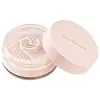Wet n Wild Megaglo Illuminating Powder Versus Rare Beauty Always an Optimist Soft Radiance Setting Powder
What's inside
What's inside
 Key Ingredients
Key Ingredients

 Benefits
Benefits

 Concerns
Concerns

 Ingredients Side-by-side
Ingredients Side-by-side

Synthetic Fluorphlogopite
Talc
AbrasiveNylon-12
Magnesium Myristate
Ethyl Macadamiate
Skin ConditioningDimethicone
EmollientPolybutene
Trimethylsiloxysilicate
EmollientPhenoxyethanol
PreservativeLauroyl Lysine
Skin ConditioningCaprylyl Glycol
EmollientHexylene Glycol
EmulsifyingEthylhexylglycerin
Skin ConditioningTocopherol
AntioxidantO-Cymen-5-Ol
AntimicrobialMica
Cosmetic ColorantTitanium Dioxide
Cosmetic ColorantIron Oxides
CI 77742
Cosmetic ColorantCI 16035
Cosmetic ColorantUltramarines
CI 75470
Cosmetic ColorantSynthetic Fluorphlogopite, Talc, Nylon-12, Magnesium Myristate, Ethyl Macadamiate, Dimethicone, Polybutene, Trimethylsiloxysilicate, Phenoxyethanol, Lauroyl Lysine, Caprylyl Glycol, Hexylene Glycol, Ethylhexylglycerin, Tocopherol, O-Cymen-5-Ol, Mica, Titanium Dioxide, Iron Oxides, CI 77742, CI 16035, Ultramarines, CI 75470
Mica
Cosmetic ColorantCI 77220
Cosmetic ColorantSilica
AbrasiveC12-15 Alkyl Benzoate
AntimicrobialMagnesium Myristate
Nylon-12
1,2-Hexanediol
Skin ConditioningCaprylic/Capric Triglyceride
MaskingCaprylyl Glycol
EmollientCoco-Caprylate/Caprate
EmollientEthylhexylglycerin
Skin ConditioningMagnesium Stearate
Cosmetic ColorantPolymethylsilsesquioxane
Squalane
EmollientTocopherol
AntioxidantTocopheryl Acetate
AntioxidantPhenoxyethanol
PreservativeIron Oxides
CI 19140
Cosmetic ColorantMica, CI 77220, Silica, C12-15 Alkyl Benzoate, Magnesium Myristate, Nylon-12, 1,2-Hexanediol, Caprylic/Capric Triglyceride, Caprylyl Glycol, Coco-Caprylate/Caprate, Ethylhexylglycerin, Magnesium Stearate, Polymethylsilsesquioxane, Squalane, Tocopherol, Tocopheryl Acetate, Phenoxyethanol, Iron Oxides, CI 19140
 Reviews
Reviews

Ingredients Explained
These ingredients are found in both products.
Ingredients higher up in an ingredient list are typically present in a larger amount.
Caprylyl Glycol is a humectant and emollient, meaning it attracts and preserves moisture.
It is a common ingredient in many products, especially those designed to hydrate skin. The primary benefits are retaining moisture, skin softening, and promoting a healthy skin barrier.
Though Caprylyl Glycol is an alcohol derived from fatty acids, it is not the kind that can dry out skin.
This ingredient is also used as a preservative to extend the life of products. It has slight antimicrobial properties.
Learn more about Caprylyl GlycolEthylhexylglycerin (we can't pronounce this either) is commonly used as a preservative and skin softener. It is derived from glyceryl.
You might see Ethylhexylglycerin often paired with other preservatives such as phenoxyethanol. Ethylhexylglycerin has been found to increase the effectiveness of these other preservatives.
We don't have a description for Magnesium Myristate yet.
Mica is a naturally occurring mineral used to add shimmer and color in cosmetics. It can also help improve the texture of a product or give it an opaque, white/silver color.
Serecite is the name for very fine but ragged grains of mica.
This ingredient is often coated with metal oxides like titanium dioxide. Trace amounts of heavy metals may be found in mica, but these metals are not harmful in our personal products.
Mica has been used since prehistoric times throughout the world. Ancient Egyptian, Indian, Greek, Roman, Aztec, and Chinese civilizations have used mica.
Learn more about MicaNylon-12 is a polymer. It is derived from 12-aminododecanoic acid, an omega-amino fatty acid
According to a manufacturer, it is a talc substitute. Like talc, nylon-12 gives products a satin feel. The manufacturer also claims this ingredients does not block pores and has moderate oil absorption.
This ingredient may not be reef-safe.
Learn more about Nylon-12Phenoxyethanol is a preservative that has germicide, antimicrobial, and aromatic properties. Studies show that phenoxyethanol can prevent microbial growth. By itself, it has a scent that is similar to that of a rose.
It's often used in formulations along with Caprylyl Glycol to preserve the shelf life of products.
Tocopherol (also known as Vitamin E) is a common antioxidant used to help protect the skin from free-radicals and strengthen the skin barrier. It's also fat soluble - this means our skin is great at absorbing it.
Vitamin E also helps keep your natural skin lipids healthy. Your lipid skin barrier naturally consists of lipids, ceramides, and fatty acids. Vitamin E offers extra protection for your skin’s lipid barrier, keeping your skin healthy and nourished.
Another benefit is a bit of UV protection. Vitamin E helps reduce the damage caused by UVB rays. (It should not replace your sunscreen). Combining it with Vitamin C can decrease sunburned cells and hyperpigmentation after UV exposure.
You might have noticed Vitamin E + C often paired together. This is because it is great at stabilizing Vitamin C. Using the two together helps increase the effectiveness of both ingredients.
There are often claims that Vitamin E can reduce/prevent scarring, but these claims haven't been confirmed by scientific research.
Learn more about TocopherolThis ingredient is a combination of red, black, and yellow iron oxide pigments. This combination of colors is usually found in foundation, because it results in a "skin" color.